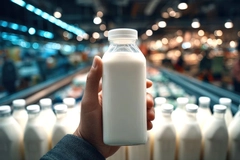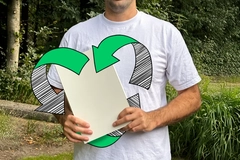“Paper’s future is hemp”: VPF combines with Gmund Papier on self-adhesive label stock

01 Feb 2022 --- VPF adhesive materials specialists in Sprockhövel, Germany, are cooperating with Gmund Papier to develop what they say is the first self-adhesive label stock made entirely from hemp.
The 120 g/m2 hemp paper consists of pure European hemp fiber, offering an environmentally sustainable alternative to conventional papers made of wood. The paper is noted for its soft feel, “excellent” printability and improved waste paper cycle.
PackagingInsights speaks with Kai Klimek, head of sales at VPF, who says unlike trees, hemp is a fast-growing and readily renewable raw material.
“Hemp paper with 100% hemp fibers is unique and brand new and hemp plants can be cultivated easily and utilized fully,” he says.
“Hemp is valued for its high durability, environmental compatibility and low energy balance. That’s why the future belongs to hemp paper.”
An abundant alternative
Klimek highlights there are many aspects proving hemp’s qualification as an alternative to wood-based paper. Among them is the fact that one field of hemp yields four to five times as much paper as a forest of the same size.
Furthermore, hemp grows to a height of up to four meters per year and therefore can be harvested three times each year. Meanwhile, trees can typically be harvested only once every seven years. Hemp grows up to four meters and can be harvested three times per year.
Hemp grows up to four meters and can be harvested three times per year.
“We see a large market for the labeling of sustainable products, cosmetics, organic food, wine and spirits,” notes Klimek.
Moreover, he explains that hemp produces more biomass than any other domestic crop. It also does not deplete the soil, “so a hemp field can be replanted immediately after the harvest.”
Since hemp plants are naturally pest-resistant, their cultivation requires fewer pesticides. It also eliminates weeds on its own, so fewer herbicides are applied.
Additionally, hemp fibers are naturally very light in color, so they require little bleaching and hardly yellow, adds Klimek.
In addition, the fibers in pulp made from hemp are five times longer than the fibers in pulp made from wood. Hemp’s long fibers also have greater tensile, tear and wet strength than wood fibers.“ The long hemp fibers improve the wastepaper cycle and can be recycled very often.”
Trials and testing
According to VPF, the main markets and applications for hemp paper are in self-adhesives. “Hemp paper is not suitable for narrow diameters, because of its long fibers,” notes Klimek.
VPF explains that after lengthy trials and aging tests, it can now coat the Gmund Hemp 100% paper (VPF 10555) with a strongly-adhesive UV acrylate, HM716UV with 25 g application weight.
Due to the adhesive’s strong final adhesion, the hemp material can also be reliably bonded to almost all more difficult substrates despite the relatively high grammage of 120 g/m.
Gmund Hemp says it can lower its carbon footprint using VPF’s 70 g recycled liner (NSA700-476) for the hemp paper’s self-adhesive finish, which consists of 70% recycled content.
On the market
The new type of hemp adhesive material is now available from VPF starting at a minimum quantity of 500 m2. Sample rolls and A4 samples can be requested.
Hemp is one of the oldest cultivated plants on earth and historically used for paper production. The Gutenberg Bible from 1455 was made of hemp paper, and until about 1880, 75-90% of the world’s paper demand was covered by hemp fibers.
By Natalie Schwertheim











